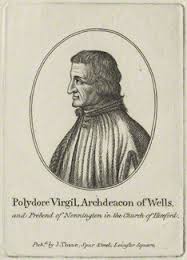On this day in history, 17th April 1595, Henry Walpole, the Jesuit martyr, was hanged, drawn and quartered in the city of York. Walpole had been accused of treason on three counts: that he "had abjured the realm without licence; that he had received holy orders overseas; and that he had returned to England as a Jesuit priest to exercise his priestly functions". Walpole was beatified in 1929 and canonised in 1970 by Pope Paul VI.
Henry Walpole was the eldest child of Christopher Walpole and Margery Warner and he was baptised in October 1558 in Docking, Norfolk. Walpole was educated at Norwich Grammar School before studying philosophy and languages at Cambridge, at Peterhouse. He also studied at Gray's Inn.
On 1st December 1581, Walpole attended the execution of the Jesuit priest Edmund Campion and was splashed with the priest's blood. Walpole saw this as a sign that he was to carry on Campion's work and he wrote a poem An Epitaph of the Life and Death of … Edmund Campion, which was published anonymously and copies of it destroyed by Elizabeth I's government. The government suspected Walpole of being the poet and after the printer was punished by losing his ears, Walpole went into hiding at Anmer Hall in Norfolk, which belonged to his family. He then escaped to France, arriving at the English College Rheims in July 1582. In 1583, he was accepted by the English College, Rome, and was ordained as a Jesuit priest in Paris on 17th December 1588.
Walpole served as a chaplain to the Spanish forces in the Netherlands under Colonel William Stanley and was arrested in Flushing after it fell to the English forces in the winter of 1589. He was released in January 1590 after one of his brothers paid a ransom. He then spent time on the continent acting as a priest.
In November 1591, Elizabeth I issued an edict against Jesuit seminary priests, which was answered by Robert Persons with his Responsio ad edictum, published under the name of Philopater. Walpole was given the task of translating it into English as an attack not on the queen herself but on her advisor, William Cecil. In 1593, Walpole was sent on an English mission by Persons. He landed at Bridlington in Yorkshire and he and his party were arrested on 7th December at Kilham and taken to York Castle where he admitted to being a Jesuit. Walpole was then taken to the Tower of London where he spent two months in solitary confinement and was racked on a number of occasions so that he would give information on seminaries in Spain and the names of their students. Antony Charles Ryan, his Oxford Dictionary of National Biographer biographer, notes that "One thing he did not do was to compromise anyone in England whose life would have been in peril as the result of revelations."
In early 1595, Walpole was sent to York for trial and was found guilty of high treason. On 17th April 1595, he was executed. Ryan writes "When the day dawned, Walpole was dragged to the place of execution on a hurdle. Once again he testified his loyalty to the queen, so that some tried to persuade the magistrate to stop the execution. On the scaffold he was pushed and hanged before he could complete his prayers. He was immediately drawn and quartered."
Further reading:
- Historia de la vida y martyrio que padecio en Inglaterra, este año de. 1595. el p. Henrique Valpolo sacerdote de la Compañia de Iesus... - A Spanish account of Walpole's life and death. This can be read online at https://books.google.es/books?id=sv2R18j7ZUEC&redir_esc=y
- One generation of a Norfolk house [the Walpoles of Houghton] by Augustus Jessopp - This can be read online at https://archive.org/details/onegenerationan00jessgoog
- "The Persecution under Elizabeth" by John H Chapman, in Transactions of the Royal Historical Society, 1881 - This can be read online at https://archive.org/stream/transactionsnew11royauoft#page/20/mode/2up
Notes and Sources
- Ryan, Antony Charles. “Walpole, Henry [St Henry Walpole] (bap. 1558, d. 1595).” Antony Charles Ryan In Oxford Dictionary of National Biography, online ed., edited by David Cannadine. Oxford: OUP, 2004. http://www.oxforddnb.com/view/article/28594
- Photo of carving - "While incarcerated in the Salt Tower, Jesuit priest Henry Walpole carved his name in the plaster along with those of saints Peter, Paul, Jerome, Ambrose, Augustine, and Gregory the Great." by Richard Nevell, Wikimedia Commons.




Rest in peace. Saint Henry Walpole.
💕🙏🏼
What? What are you saying?